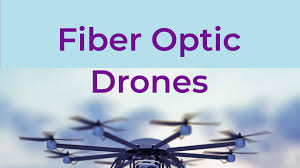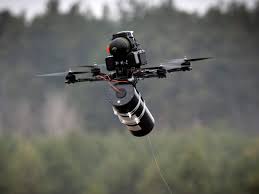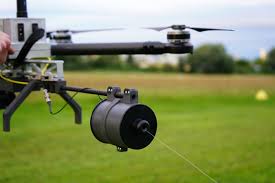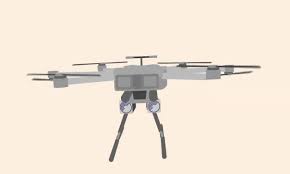
The combination of fiber-optic technology and AI-enabled drones has emerged as a groundbreaking solution across multiple industries, revolutionizing fields like telecommunications, surveillance, inspection, and data collection. These drones leverage the speed and bandwidth of fiber optics along with the intelligence and autonomy provided by AI to perform complex tasks more efficiently and effectively.
1. Introduction
Fiber-optic technology is known for its high-speed data transmission capabilities, which allow for the transfer of large volumes of information over long distances with minimal signal degradation. AI-enabled drones are equipped with advanced machine learning algorithms that enable them to process data in real time, make autonomous decisions, and adapt to their environment.
When combined, fiber-optic technology ensures these drones can transmit high-quality video, sensor data, and other real-time information without delays or interruptions. AI enhances their performance by enabling autonomous flight, advanced data analysis, and decision-making capabilities.
2. Applications of Fiber-Optic and AI-Enabled Drones

a. Telecommunications and Network Maintenance
Fiber-optic networks are crucial for high-speed internet and communication systems. AI-enabled drones equipped with fiber-optic cables can be used to inspect, maintain, and repair these networks.
- Inspection and Monitoring: Drones can fly along fiber-optic cables to detect faults, such as breaks or signal interference, while transmitting real-time data for immediate analysis. AI can predict areas of the network that are prone to issues, allowing for proactive maintenance.
- Repairs and Upgrades: In some cases, drones can autonomously perform minor repairs or deliver components to remote locations to enhance the efficiency of network maintenance operations.
b. Environmental Monitoring and Surveying
AI-powered drones with fiber-optic communication can be deployed in challenging environments such as forests, mountains, or remote areas to collect data for environmental monitoring.
- Real-Time Data Transmission: Fiber-optic technology ensures that high-resolution imagery, sensor data (such as temperature, humidity, and air quality), and video footage can be transmitted to monitoring stations in real time.
- AI for Data Analysis: The AI onboard the drone can analyze the collected data in real time, providing instant feedback on the state of the environment. This is crucial for applications like wildlife tracking, deforestation monitoring, or pollution detection.
c. Search and Rescue Operations
AI-enabled drones have proven to be an invaluable asset in search and rescue missions, particularly in hard-to-reach or hazardous areas.
- Autonomous Navigation: AI allows drones to navigate complex environments, such as collapsed buildings or dense forests, with little human intervention.
- Fiber-Optic Communication for Live Feed: Fiber-optic cables can be used to transmit high-definition live feeds from the drone’s cameras, allowing rescue teams to assess situations more accurately from a safe distance.
d. Surveillance and Security
The security industry benefits from the synergy between fiber-optic and AI-enabled drones, which can cover large areas and provide real-time surveillance footage.
- Autonomous Patrolling: AI allows drones to autonomously patrol designated areas, identifying potential threats based on predefined security patterns.
- High-Speed Data Transmission: The fiber-optic connection ensures that high-quality video streams are transmitted without lag, enabling security teams to monitor activities continuously and respond faster to security breaches.
3. Advantages of Fiber-Optic and AI-Enabled Drones

a. Enhanced Efficiency
The combination of fiber-optic communication and AI results in drones that are faster, more autonomous, and capable of transmitting real-time data. This boosts operational efficiency in tasks like inspection, monitoring, and maintenance.
b. Data Quality and Reliability
Fiber-optic technology provides high bandwidth and low latency, which is essential for transmitting large amounts of data, including high-definition video feeds and sensor data. AI algorithms ensure that only relevant data is processed, further optimizing operations.
c. Autonomy and Reduced Human Intervention
AI allows drones to operate autonomously, reducing the need for human intervention. This is particularly useful in dangerous or remote environments where human access might be limited or risky.
d. Cost-Effectiveness
By reducing the need for ground-based infrastructure and human labor, AI-enabled drones with fiber-optic communication can help lower the costs of monitoring, inspection, and maintenance across industries.
4. Challenges and Future Outlook
While fiber-optic and AI-enabled drones offer numerous advantages, there are challenges such as regulatory concerns, the need for robust AI algorithms, and the complexity of managing large fleets of drones.
- Regulatory Compliance: Drones must operate in compliance with airspace regulations, and their use for certain tasks (like surveillance) may require specific permissions.
- AI Development: Ensuring that AI algorithms are accurate and effective in various real-world situations is a key challenge, especially in autonomous decision-making.
Despite these challenges, the potential of fiber-optic and AI-enabled drones continues to expand. As technology advances, these drones will likely play an even more integral role in transforming industries, enhancing operations, and improving overall safety and efficiency.
Conclusion

The integration of fiber-optic technology with AI-enabled drones represents a significant leap forward in various sectors, offering solutions that are faster, more reliable, and more efficient than traditional methods. As these technologies evolve, the potential applications for fiber-optic and AI-powered drones are vast, and they will continue to revolutionize industries such as telecommunications, surveillance, and environmental monitoring.
